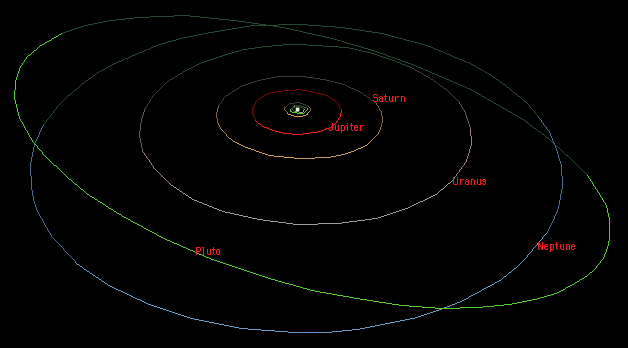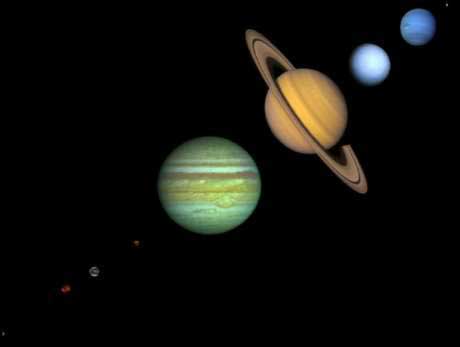The solar system consists of the Sun; the eight official planets, at least three “dwarf planets”, more than 130 satellites of the planets, a large number of small bodies (the comets and asteroids), and the interplanetary medium. (There are probably also many more planetary satellites that have not yet been discovered.)
Orbits
The solar system consists of the Sun; the eight official planets, at least three “dwarf planets”, more than 130 satellites of the planets, a large number of small bodies (the comets and asteroids), and the interplanetary medium. (There are probably also many more planetary satellites that have not yet been discovered.)
The inner solar system contains the Sun, Mercury, Venus, Earth and Mars:

The main asteroid belt (not shown) lies between the orbits of Mars and Jupiter. The planets of the outer solar system are Jupiter, Saturn, Uranus, and Neptune (Pluto is now classified as a dwarf planet):

The first thing to notice is that the solar system is mostly empty space. The planets are very small compared to the space between them. Even the dots on the diagrams above are too big to be in proper scale with respect to the sizes of the orbits.
The orbits of the planets are ellipses with the Sun at one focus, though all except Mercury are very nearly circular. The orbits of the planets are all more or less in the same plane (called the ecliptic and defined by the plane of the Earth’s orbit). The ecliptic is inclined only 7 degrees from the plane of the Sun’s equator. The above diagrams show the relative sizes of the orbits of the eight planets (plus Pluto) from a perspective somewhat above the ecliptic (hence their non-circular appearance). They all orbit in the same direction (counter-clockwise looking down from above the Sun’s north pole); all but Venus, Uranus and Pluto also rotate in that same sense.
(The above diagrams show correct positions for October 1996 as generated by the excellent planetarium program Starry Night; there are also many other similar programs available, some free. You can also use Emerald Chronometer on your iPhone or Emerald Observatory on your iPad to find the current positions. This information is also useful for designing a solar panel system.)
Sizes

The above composite shows the eight planets and Pluto with approximately correct relative sizes (see another similar composite and a comparison of the terrestrial planets or Appendix 2 for more).
One way to help visualize the relative sizes in the solar system is to imagine a model in which everything is reduced in size by a factor of a billion. Then the model Earth would be about 1.3 cm in diameter (the size of a grape). The Moon would be about 30 cm (about a foot) from the Earth. The Sun would be 1.5 meters in diameter (about the height of a man) and 150 meters (about a city block) from the Earth. Jupiter would be 15 cm in diameter (the size of a large grapefruit) and 5 blocks away from the Sun. Saturn (the size of an orange) would be 10 blocks away; Uranus and Neptune (lemons) 20 and 30 blocks away. A human on this scale would be the size of an atom but the nearest star would be over 40000 km away.
Not shown in the above illustrations are the numerous smaller bodies that inhabit the solar system: the satellites of the planets; the large number of asteroids (small rocky bodies) orbiting the Sun, mostly between Mars and Jupiter but also elsewhere; the comets (small icy bodies) which come and go from the inner parts of the solar system in highly elongated orbits and at random orientations to the ecliptic; and the many small icy bodies beyond Neptune in the Kuiper Belt. With a few exceptions, the planetary satellites orbit in the same sense as the planets and approximately in the plane of the ecliptic but this is not generally true for comets and asteroids. The classification of these objects is a matter of minor controversy. Traditionally, the solar system has been divided into planets (the big bodies orbiting the Sun), their satellites (a.k.a. moons, variously sized objects orbiting the planets), asteroids (small dense objects orbiting the Sun) and comets (small icy objects with highly eccentric orbits). Unfortunately, the solar system has been found to be more complicated than this would suggest:
- there are several moons larger than Pluto and two larger than Mercury;
- there are many small moons that are probably started out as asteroids and were only later captured by a planet;
- comets sometimes fizzle out and become indistinguishable from asteroids;
- the Kuiper Belt objects (including Pluto) and others like Chiron don’t fit this scheme well
- The Earth/Moon and Pluto/Charon systems are sometimes considered “double planets”.
Other classifications based on chemical composition and/or point of origin can be proposed which attempt to be more physically valid. But they usually end up with either too many classes or too many exceptions. The bottom line is that many of the bodies are unique; the actual situation is too complicated for simple categorization. In the pages that follow, I will use the conventional categorizations.
The eight bodies officially categorized as planets are often further classified in several ways:
- by composition:
- terrestrial or rocky planets: Mercury, Venus, Earth, and Mars:
- The terrestrial planets are composed primarily of rock and metal and have relatively high densities, slow rotation, solid surfaces, no rings and few satellites.
- jovian or gas planets: Jupiter, Saturn, Uranus, and Neptune:
- The gas planets are composed primarily of hydrogen and helium and generally have low densities, rapid rotation, deep atmospheres, rings and lots of satellites.
- terrestrial or rocky planets: Mercury, Venus, Earth, and Mars:
- by size:
- small planets: Mercury, Venus, Earth, Mars.
- The small planets have diameters less than 13000 km.
- giant planets: Jupiter, Saturn, Uranus and Neptune.
- The giant planets have diameters greater than 48000 km.
- The giant planets are sometimes also referred to as gas giants.
- small planets: Mercury, Venus, Earth, Mars.
- by position relative to the Sun:
- inner planets: Mercury, Venus, Earth and Mars.
- outer planets: Jupiter, Saturn, Uranus, Neptune.
- The asteroid belt between Mars and Jupiter forms the boundary between the inner solar system and the outer solar system.
- by position relative to Earth:
- inferior planets: Mercury and Venus.
- closer to the Sun than Earth.
- The inferior planets show phases like the Moon’s when viewed from Earth.
- Earth.
- superior planets: Mars thru Neptune.
- farther from the Sun than Earth.
- The superior planets always appear full or nearly so.
- inferior planets: Mercury and Venus.
- by history:
- classical planets: Mercury, Venus, Mars, Jupiter, and Saturn.
- known since prehistorical times
- visible to the unaided eye
- in ancient times this term also refered to the Sun and the Moon; the order was usually specificied as: Saturn, Jupiter, Mars, Sun, Venus, Mercury and Moon, based on the time for them to go “all the way round” the sphere of the “fixed” stars).
- modern planets: Uranus, Neptune.
- discovered in modern times
- visible only with optical aid
- Earth.
- The IAU decided that “classical” should refer to all eight planets (Mercury thru Neptune, including Earth but not Pluto). This is contrary to historical usage but makes some sense from a 21st century perspective.
- classical planets: Mercury, Venus, Mars, Jupiter, and Saturn.
PicturesNote: most of the images in The Nine Planets are not true color. Most of them were created by combining several black and white images taken thru various color filters. Though the colors may look “right” chances are they aren’t exactly what your eye would see.
- The Nine Planets montage (larger version of the above) 36k jpg
- Another relative size comparison (from LANL) 93k gif
- Sun and large planet comparison (from Extrema) 15k jpg
- Earth and small body comparison (from Extrema) 13k jpg
- Voyager 1 mosaic of the solar system from 4 billion miles out 36k jpg; html (caption)
- Voyager 1 images of 6 planets from 4 billion miles out 123k jpg; html
- Pale Blue Dot, reflections on the above image by Carl Sagan.
More General Overview
- The largest, smallest, brightest, etc bodies
- The history of solar system discovery
- Solar System Introduction from LANL
- Solar System Family Portrait from NSSDC
- Solar System Live, the interactive Orrery of the Web.
- notes about the most distant object in the solar system and the surface temperatures of the planets from RGO
- scale models of the solar system
- A Solar System Scale Model Meta Page (links to many others)
- the Voyage Scale Model Solar System on the National Mall in Washington DC
- Lakeview Museum Community Solar System, the world’s largest model of the solar system
- scale model from LPI
- Sagan Planet Walk in Ithaca, NY
- Build a Solar System, a neat scale model calculator
- Silver City, NM Sidewalk Solar System
- Solar System Walk in Gainesville, Florida
- Eugene Oregon Scale Model Solar System
- Bonsall Elementary
- PlanetTrek, a solar system scale model for Pasadena
- Phenix City Intermediate School
- Walk the Solar System, a nice size comparison calculator from the Exploratorium
Meta Calc, a simple online calculator - Your Weight on Other Worlds, another neat calculator from the Exploratorium
- ConverTable Planets, a nice little Macintosh app to calculate your weight on other planets
- Galileo SSI Education Module on Planetary Surfaces
- a good bibliography of print material about the solar system
The Big Questions
What is the origin of the solar system? It is generally agreed that it condensed from a nebula of dust and gas. But the details are far from clear.
How common are planetary systems around other stars? (Updated June 2014)
The number of planets around other stars has increased dramatically since the first discoveries of HD 1144762 b in 1989 and gamma Cephei b in 1988 (confirmed in 2003). exoplanet.eu lists 1,811 planets up to 25 July 2014, including over 400 multiple planet systems. Plus there are over 3,000 additional potential planets indicated by the Kepler spacecraft according to the NASA Exoplanet Archive. The reader will note there may be differences in the reported numbers between the two sites referenced.
What conditions allow the formation of terrestrial planets? It seems unlikely that the Earth is totally unique but we still have no direct evidence one way or the other.
Is there life elsewhere in the solar system? If not, why is Earth special? (Updated June 2014)
We do not yet know of life elsewhere. One of the things that makes Earth special of particular interest to the exoplanet search is our location with respect to our Sun — the habitable or so-called “goldilocks zone”. The “goldilocks zone” the area around a star where water would be a liquid on the surface of a planet. The location and extent of which would depend on a number of criteria such as the parent star size and temperature. Once planets in these habitable zones are found the size of the planet is taken into account. The size is what may enable a suitable atmosphere for our familiar life forms. The Planetary Habitability Laboratory at the University of Puerto Rico at Arecibo maintains the Habitable Exoplanet Catalog
Is there life beyond the solar system? Intelligent life?
Is life a rare and unusual or even unique event in the evolution of the universe or is it adaptable, widespread and common?
Answers to these questions, even partial ones, would be of enormous value. Answers to the lesser questions on the pages that follow may help answer some of these big ones.


